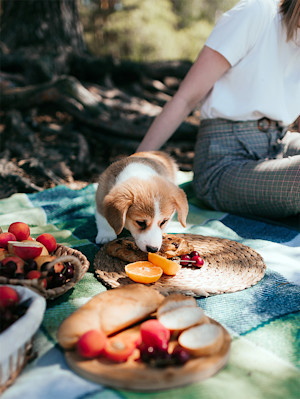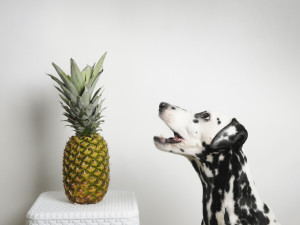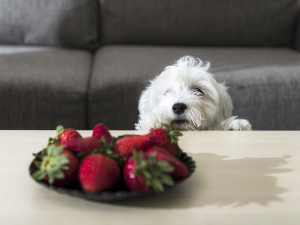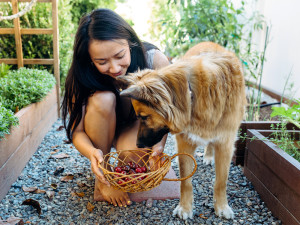
Share Article
Cantaloupe is one of those fruits that’s so good it almost passes as dessert; it’s refreshing and filled with nutrients. Many dogs like to eat just about anything their parents are eating, and you feel guilty eating in front of them without sharing.
However, you can’t just share anything you’re consuming with your dog without discovering if it’s safe. We’re going to do just that with cantaloupe. We’ll look into the safety, benefits, potential risks, correct serving sizes, and safe ways to incorporate cantaloupe into recipes, especially for your pup.
Is cantaloupe safe for dogs to eat?
Regarding safety, which is always the first concern, cantaloupe is indeed safe for your dog. That is if you give it in moderation. It’s not meant to be the main meal. Think of it instead as a treat. This low-calorie, high-water content food is an excellent treat, especially in hot weather. You must, however, prepare it properly to ensure it’s safe.
Is cantaloupe good for dogs?
There are definite health benefits for your dog if eating cantaloupe. They include:

Vitamins and minerals: Cantaloupe contains vitamins B6, niacin, potassium, and folic acid, which support various bodily functions, including immune health and vision.
Antioxidants: Vitamins A and C, which help fight oxidative stress, which may help lower the risk of chronic disease.
Cantaloupe offers several health benefits for dogs:
Hydration: The high water content in cantaloupe helps keep your dog from becoming dehydrated during the warmer months.
Fiber: Healthy digestion and regular bowel movements are maintained with fiber in the diet.
Can cantaloupe be bad for dogs?
Despite the benefits of cantaloupe for your pup, there actually are some risks, including:
High-sugar content: Cantaloupe contains natural sugars, which means a dog with diabetes can’t eat it. Also, if your dog tends to be overweight, feeding it wouldn’t be good. It's best to consult your veterinarian before offering cantaloupe to dogs with these conditions.
Choking hazard: Dogs can choke on the cantaloupe’s rind, which can also cause intestinal blockage. Always remove the rind and seeds before offering the fruit to your dog.
Digestive upset: Any new food introduced to your dog can cause intestinal problems. If you give your dog a bit of cantaloupe, start with a small amount and monitor them for vomiting or diarrhea.
Food-borne illness: Severe vomiting, diarrhea, or dehydration can occur if bacteria are living on the food your pet eats. Ensure to wash the whole fruit before slicing to reduce the risk of your dog getting a food-borne disease.
How much cantaloupe can dogs eat?
Treats, the category of food that cantaloupe would go in, should never make up more than 10 percent of your dog’s diet. Here’s a rough example of how much cantaloupe your pup should eat:
Small dogs: A few small cubes should suffice.
Medium dogs: A handful of bite-sized pieces is appropriate.
Large dogs: They can tolerate a bit more, but always in moderation.
Always start with small amounts and monitor your dog for signs of digestive upset.
What if your dog eats too much cantaloupe?
If your dog eats a large amount of cantaloupe, watch for intestinal problems such as:
Vomiting
Diarrhea
Lethargy
Abdominal discomfort
If any of these signs occur, call your vet right away.
How to safely feed your dog cantaloupe
Follow these steps before you feed cantaloupe to your dog:
Wash the rid thoroughly out of caution.
Remove rind and seeds.
Cut into bite-sized pieces.
Here are some creative ways to serve cantaloupe to your dog:
Putting it in a smoothie
Blend cantaloupe with other dog-safe fruits, such as blueberries or strawberries, and a bit of water to create a refreshing smoothie. Serve it in a bowl or fill a Kong toy with it for a fun treat.
Yogurt
Mix small cantaloupe pieces with plain, unsweetened yogurt for a probiotic-rich snack. Ensure the yogurt does not contain artificial sweeteners like xylitol, which are toxic to dogs.
Doggie ice cream
Mix puree cantaloupe with plain yogurt or a small amount of peanut butter (ensure it’s xylitol-free). Freeze the mixture in ice cube trays to create dog-friendly ice cream, perfect for hot days. You know how dogs like to play with ice cubes.
Using it as a food topper
Add finely chopped cantaloupe pieces to your dog’s regular food to entice picky eaters and provide a nutritional boost.
Popsicles
You can create simple popsicles by freezing cantaloupe puree in molds or ice cube trays. For added flavor, you can add other dog-safe fruits or a bit of low-sodium chicken broth.
Bottom line
Cantaloupe is an excellent warm-weather treat for people and their dogs. It’s safe for dogs if you follow a few steps. Remove the rind and seeds. Wash thoroughly. Cut into small bites. Feed them to your pup as is, or use one of the recipes we mentioned.
If your dog has never eaten cantaloupe, feed them a small amount and monitor them closely afterward. You can provide them with a tasty, refreshing, and nutritious snack following proper preparation methods and portion control.
References
Soffer, Nitzan, et al. “Bacteriophages Safely Reduce Salmonella Contamination in Pet Food and Raw Pet Food Ingredients.” Bacteriophage, vol. 6, no. 3, 2 July 2016, p. e1220347, https://doi.org/10.1080/21597081.2016.1220347opens in new tab.
“Toxic and Non-Toxic Plant List - Dogs.” ASPCA, 2015, www.aspca.org/pet-care/animal-poison-control/dogs-plant-listopens in new tab.

Dr. Shelby Neely, DVM
Dr. Shelby Neely is a freelance writer and veterinarian who graduated from the University of Pennsylvania School of Veterinary Medicine and has practiced veterinary medicine for 30 years, specializing in small animals. Her work has appeared in Allivet, AsktheCatDoctor, WhiskerDocs, Ask the Cat Doctor Radio, Ask the Cat Doctor TV, and numerous other websites, brochures, newsletters, newspapers, and ebooks. In her spare time, Dr. Neely likes to spend time with her three children, two grandchildren, three cats, two grand-cats, and five grand-dogs.
Related articles
Can Dogs Eat Peaches?
It’s the best fruit of the season, after all.
Can Dogs Eat Strawberries?
In moderation, strawberries are a tasty, healthy treat for your pup.
Can Dogs Eat Papaya?
They’re a nutritious treat for dogs. Here’s why.
Can Dogs Eat Kiwi?
If they’re even interested, that is.
![Woman holding basket of cherries next to large brown dog.]()
Can Dogs Eat Cherries?
Find out if the yummy fruit is safe to share.
Can Dogs Eat Pears?
It can be a fruit with an acquired taste, but can your pup... acquire it?








